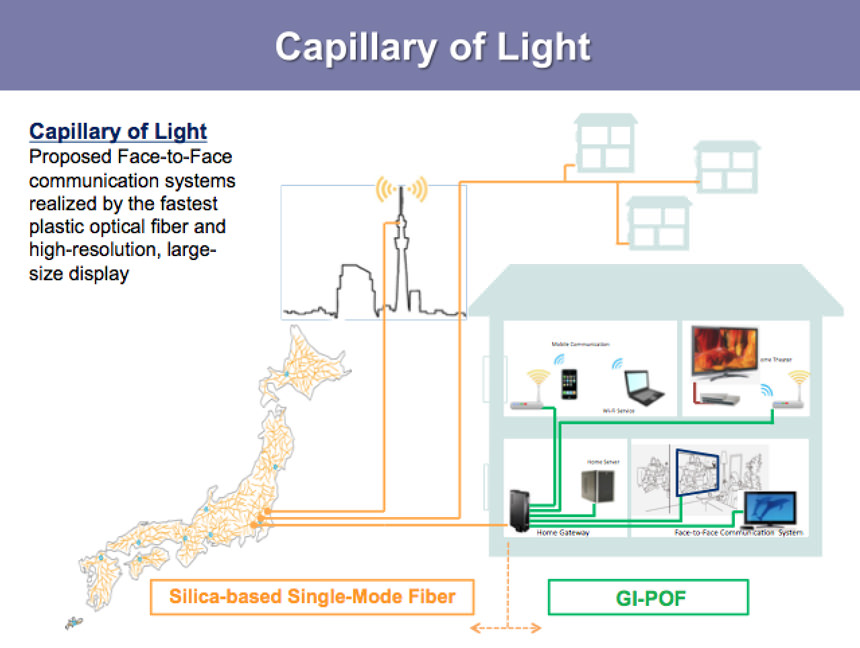Ultra-High Speed Plastic Optical Fiber
We will develop ultra high-speed graded index plastic optical fiber (GI POF) through innovative co-extrusion process using new photonics polymers.
The core technology supporting sub-theme 1 is the world's fastest graded index plastic optical fiber (GI POF) which was created from the results of Professor Koike's basic research into light and polymers over a 30 year span.
This KPRI research theme aspires to contribute to the building of a society which affords peace of mind by enabling communication at any time with remote friends and family through a visual medium with a realistic sense of presence. We are proposing to lay this GI POF inside homes and buildings and to outfit an optical information communication network comprised of "capillary of light" throughout Japan.
Currently, existing glass optical fiber is deployed to homes (to outside the home), and metal cables are mainstream inside the home. In order to build a higher speed and higher capacity information communication network, it is necessary to lay an optical network extending inside the home. The thin glass optical fiber being considered for this purpose requires high precision alignment of the connection area, and high cost is the main obstacle to its diffusion. In contrast, GI POF possesses the material characteristics of being highly flexible, difficult to break, easy to handle as it is large diameter, and does not require high precision alignment. Presently, this GI POF is attracting a great amount of attention as a main candidate for a high speed optical communication medium inside the home. For this research theme, a series of developments from material design to manufacturing technology is being pursued in order to maximize the properties of GI POF.
Latest Research Results
Error-free POF (Plastic Optical Fiber)
With the advent of the AI and IoT era, large-capacity and high-quality data communication has become an essential requirement for servers and computer equipment. However, as signal speeds increase, it becomes more difficult to transmit data without errors. Consequently, current communication systems typically employ various signal processing techniques, such as forward error correction (FEC), to correct errors that occur during data transmission. Nevertheless, these signal processing techniques cause serious problems of increased power consumption and communication delay in communication systems.
Error-free POF eliminates the need for error correction techniques in communication systems, thereby solving the problems of heat generation, communication delay, and cost all at once.
In particular, with the rapid proliferation of generative AI, as exemplified by ChatGPT, the issues of power consumption, heat generation, and communication delay in data centers have become urgent challenges. Error-Free POF has the great potential to become a key technology for next-generation data centers.
The achievement of Error-free POF was announced in a press release by Keio University in September 2021 and was covered by media outlets, including NHK News and the Nikkei. Additionally, it was selected as a highlight topic at the American Physical Society (APS) meeting in March 2023, and an introduction video of Error-free POF is available on the APS TV YouTube channel.
Related publication:
・ Y. Koike and K. Muramoto, Opt. Lett., 46, 3709 (2021).
+ What is graded index plastic optical fiber (GI POF)?
Optical fiber is comprised of two coaxial layers of dielectric the core region is surrounded by the cladding made from the other material with a lower refractive index than the core. As well, silica based optical fiber can be divided into single mode fiber (SMF) which has only one mode of propagation within the fiber, and multimode fiber (MMF) which has multiple modes of propagation. On the other hand, most POF used is MMF.
Moreover, MMF can be surrounded into step index (SI) POF with uniform refractive index within the core region, and GI POF in which the refractive index gradually changes. With SI POF, the output pulse broadens through large modal dispersion, and with GI POF, an output pulse does not differ from the input pulse. So, GI POF is capable of high speed transmission.
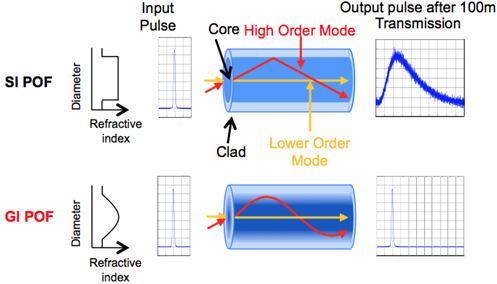
Silica Based Single Mode Fiber (SMF)

- Merits
-
- High-speed transmission of more than 10 Tb/s
- Compatible with long distance trunk line
- Demerits
-
- Requires expensive connectors and lens system, and laying costs are high
- Due to its mechanical characteristics, it is difficult to make silica material large diameter
Fiber network for the trunk line is laid in SMF.
Step Index Multimode Fiber (SI POF)

- Merits
-
- Low cost
- Handling is easy as it has been made large diameter
- Not easily affected by EM noise
- Demerits
-
- Low speed of less than 1 gigabit
- Can only be used at short distances of 10-100 m
Used as a vehicle LAN in Europe
Graded Index Multimode Fiber(GI POF)

- High speed transmission (40 Gb/s@1.55 μm) exceeding silica based multimode fiber
- Demonstrated considerable improvement in bending loss and is expected as a cable inside the home


+ Transmission properties of GI POF
In 2008, Koike Laboratory succeeded in a 40 Gbps high speed transmission experiment at 100 m utilizing a perfluorinated GI POF manufactured through the co-extrusion process. Perfluorinated polymers realize lower transmission loss compared to other polymers such as PMMA. As well, as the wavelength dependence of the refraction index is small, it possesses the essential material characteristic that its material dispersion (which is a limiting factor in optical fiber transmission speed) is smaller than PMMA and glass. In other words, an essentially broad wavelength range enables high speed transmission.
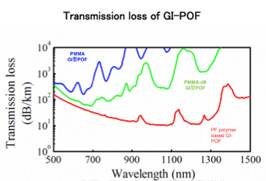

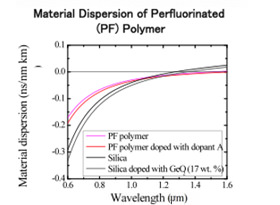
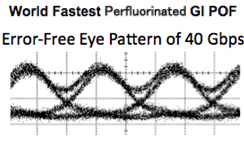
ECOC2008(Brussels, Belgium), We.2.A.4.
+ Co-Extrusion Process for Preparing GI POF developed at Koike Laboratories
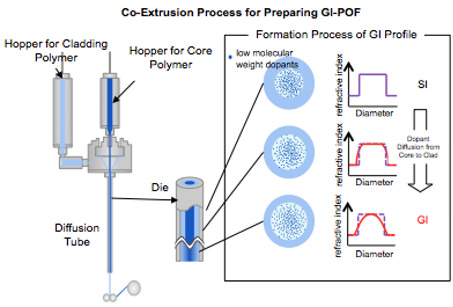
Co-Extrusion Process diffuses the dopant and forms a refractive index profile by separately melting core plastic which includes clad and high refractive index dopant, and by performing concentric extrusion molding, fusing, and heating. This method, in principle, enables semi-permanent continuous production by supplying plastic as the material.
Research Results of FIRST Program
+ Development of Mass Production Technology through GI POF Co-Extrusion Process
As the diffusion coefficient depends on the dopant concentration, and as advection diffusion must be considered, former Fick's diffusion laws cannot be applied as they are. We clarified the concentration dependency of the diffusion coefficient from the interaction between the dopant and polymer matrix, and established a very practical refractive index profile control technology which considers advection diffusion. As a result, we have been able to quantitatively pursue optimal conditions (optimal diffusion temperature, optimal diffusion tube length, etc.) for this extrusion system.

+ Molecular Design of Low Loss and Low Cost Polymers
Through partial halogenation of low cost polymers for large diameter GI POF, we have succeeded in reducing transmission loss through CH vibrational absorption, and have developed a polymer material which is both low cost and low loss. Through copolymerization of acrylic resin and other resins, pyrolysis characteristics and mechanical characteristics have been significantly improved, mass production utilizing the co-extrusion process has been made possible, and we have succeeded in suppressing production costs.
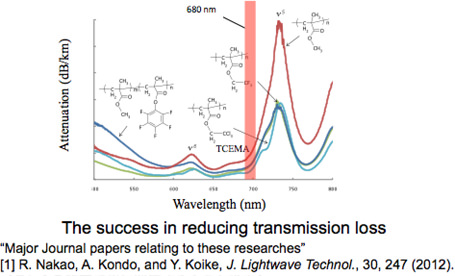
+ Establishment of Radio over Fiber (RoF) transmission technology
Through this new GI POF, we have succeeded in Radio over Fiber (RoF) transmission in which modal noise does not essentially occur. Multimode optical fiber is thought to be ill-suited for RoF, which is now attracting attention, as it is essentially accompanied by modal noise. But our research has overturned this notion and is having a huge impact on optical communications industry participants. These details were reported for the first time during the keynote lecture at POF2012 and the invited lecture at ECOC2012 international conferences in September 2012.
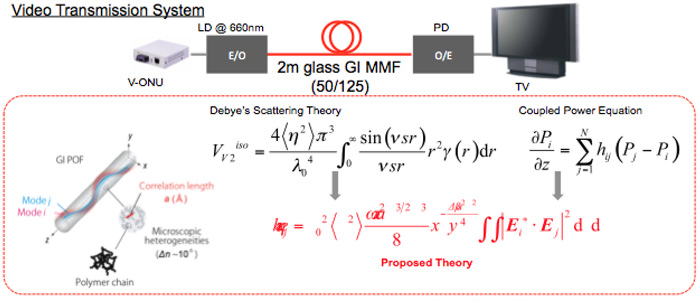
+ Development of Ultra High Speed Active Optical HDMI Cables
We are developing optical HDMI cables with 10 Gbps transmission using ultra high speed GI POF made of perfluorinated polymers. As the prototype Optoelectonic High-Speed HDMI Cable performs optic-electric conversion at both ends of the GI POF, it enables optical transmission simply by inserting it into the former HDMI terminal. This marks a large step toward the practical application of GI POF. In the future, we will aim for the trial manufacture and practical application of all optical cables.

"Major Journal papers and patents relating to these researches"
- N. Schlepple, M. Nishigaki, H. Uemura, H. Futuyama, Y. Sugizaki, H. Shibata, and Y. Koike, IEEE Photon. Technol. Lett. Vol. 24, No.19, pp. 1670-1672, 2012.
- One patent pending

